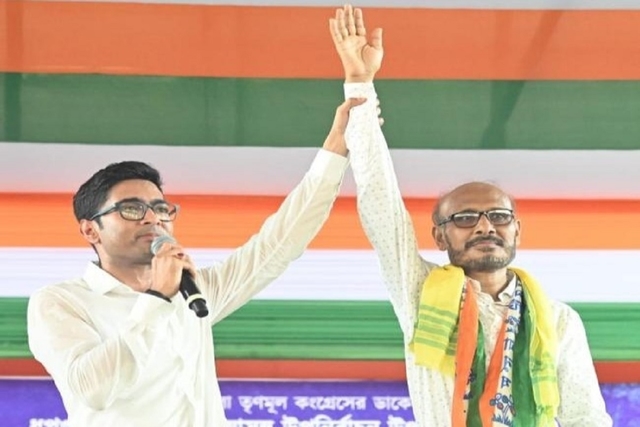West Bengal
Bengal Bypolls: Trinamool Wins Back Dhupguri In North Bengal From BJP
- BJP hoped to gain from a host of factors, which seemed to have worked, but not well enough for a victory.
- Analysts say that the Muslims voted en masse for the Trinamool, thus giving it the edge and helping Nirmal Chandra Roy win by over 4,000 votes.

Trinamool general secretary Abhishek Banerjee with party candidate Nirmal Chandra Roy.
The Trinamool Congress wrested the Dhupguri Assembly seat in North Bengal from the Bharatiya Janata Party (BJP). By-elections to the seat were held Tuesday (5 September).
The Trinamool’s Nirmal Chandra Roy trounced his nearest BJP rival, Tapasi Roy, by 4,313 votes. The Congress-backed CPI(M) candidate Ishwar Chandra Roy came a distant third.
The Trinamool is touting its victory in Dhupguri as proof of its comeback in North Bengal, which is regarded as a BJP stronghold.
Trinamool’s Nirmal Chandra Roy, a professor of history at Dhupguri Girls’ College, got 96,961 votes while BJP’s Tapasi Roy secured 92,648 votes. The CPI(M)’s Ishwar Chandra Roy could get only 13,666 votes.
The election was a hard-fought one. What turned the tide in the Trinamool’s favour was the announcement by its general secretary, Abhishek Banerjee, at the eleventh hour that Dhupguri would be elevated to a sub-division from its present status of a community development block.
Also, the BJP’s organisational weaknesses cost it dear. Despite winning all the Lok Sabha seats from North Bengal in 2019 and a majority of the Assembly seats from the region in 2021, the BJP failed to strengthen its organisational base in the region.
What also worked in the Trinamool’s favour is that it is the ruling party. By-elections are usually won by the ruling party because the electorate wants development of their area and knows that only the ruling party can ensure development and progress.
Dhupguri had been a CPI(M) bastion since 1977 when the Left Front came to power in Bengal and even withstood the Trinamool wave of 2011, that put Mamata Banerjee in the chief minister’s seat.
In 2011, the CPI(M)’s Mamata Roy had defeated the Trinamool’s Mina Barman by over 4,200 votes, but the Trinamool’s Mitali Roy wrested the seat from the Marxists in 2016 by a margin of nearly 20,000 votes.
However, in the 2021 Assembly elections, the BJP’s Bishnu Pada Roy defeated Trinamool’s Mitali Roy by a margin of 4,355 votes.
The by-elections have been necessitated by the death of incumbent MLA Bishnu Pada Roy in July this year.
Rajbongshis, who fall in the Scheduled Caste (SC) category, form nearly 60 per cent of the population of Dhupguri. The Gorkhas and tea tribes — tribals brought by the British to work as labourers in tea plantations — from another 18 per cent of the electorate of Dhupguri which falls in Jalpaiguri district.
Muslims — all migrants from Bangladesh — form about 8-10 per cent percent of the electorate of Dhupguri, while Bengali Hindus constitute the remaining 14 per cent of the population.
Chief Minister Mamata Banerjee has been actively wooing the Rajbongshis, the tea tribes and also the Gorkhas with a number of welfare projects and doles.
Though Rajbongshis, tea tribes and Gorkhas besides Bengali Hindus who have fled persecution in Bangladesh, form the BJP’s strong support base in the region, the Trinamool has, through a carrot and stick policy, managed to wean away some sections of all these groups.
The BJP had banked on a few factors, including its choice of candidate for the seat, to win. The saffron party had fielded Tapasi Roy, widow of CRPF trooper Jagannath Roy who was martyred in the Pulwama suicide attack in February 2019.
The BJP had also expected to benefit from the defection of Mitali Roy, who had won Dhupguri on a Trinamool ticket in 2016. Roy had crossed over to the BJP along with a couple of hundred of her followers Sunday (3 September).
Mitali Roy, who was associated with the Kamtapur Liberation Organisation (KLO), is popular among a wide cross-section of Rajbongshis. The BJP had hoped to gain from that popularity.
The BJP had also expected the goodwill of the Rajbongshi community after it nominated prominent community leader Ananta Roy ‘Maharaj’ to the Rajya Sabha in July this year.
Ananta ‘Maharaj’, as he is popularly known, commands tremendous support and respect within his community and has been demanding the formation of a separate Kamtapur state.
The BJP had also tried to woo the Rajbongshis with the award of Padma Shri to a widely-respected educationist, Dharma Narayan Barma, who has been fighting for recognition for the Rajbongshi language for many decades.
These factors worked, but not well enough to ensure a victory for the BJP candidate.
Analysts say that the Muslims voted en masse for the Trinamool, thus giving it the edge and helping Nirmal Chandra Roy win by over 4,000 votes.
Support Swarajya's 50 Ground Reports Project & Sponsor A Story
Every general election Swarajya does a 50 ground reports project.
Aimed only at serious readers and those who appreciate the nuances of political undercurrents, the project provides a sense of India's electoral landscape. As you know, these reports are produced after considerable investment of travel, time and effort on the ground.
This time too we've kicked off the project in style and have covered over 30 constituencies already. If you're someone who appreciates such work and have enjoyed our coverage please consider sponsoring a ground report for just Rs 2999 to Rs 19,999 - it goes a long way in helping us produce more quality reportage.
You can also back this project by becoming a subscriber for as little as Rs 999 - so do click on this links and choose a plan that suits you and back us.
Click below to contribute.
Latest